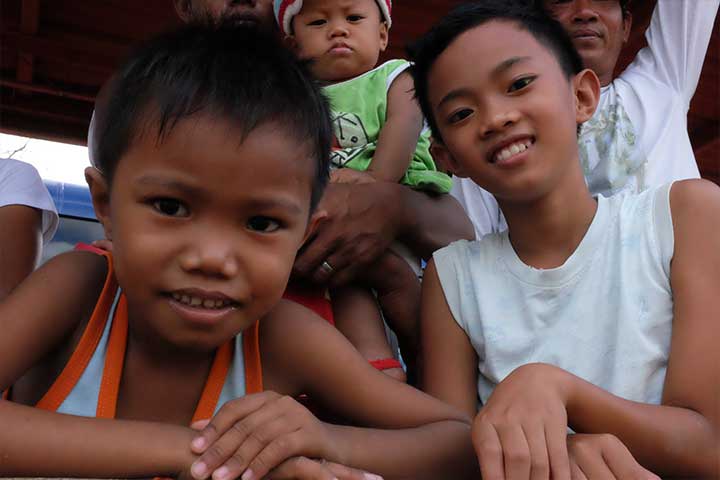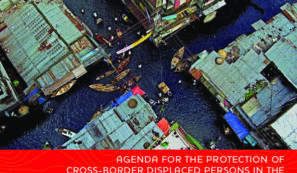
refers to a “serious disruption of the functioning of a community or a society involving widespread human, material, economic or environmental losses and impacts, which exceeds the ability of the affected community or society to cope using its own resources.” (UNDRR) In the Protection Agenda, disasters refer to disruptions triggered by or linked to hydro-metrological and climatological natural hazards, including hazards linked to anthropogenic global warming, as well as geophysical hazards.
refers to a “serious disruption of the functioning of a community or a society involving widespread human, material, economic or environmental losses and impacts, which exceeds the ability of the affected community or society to cope using its own resources.” (UNDRR) In the Protection Agenda, disasters refer to disruptions triggered by or linked to hydro-metrological and climatological natural hazards, including hazards linked to anthropogenic global warming, as well as geophysical hazards.
refers to three forms of population movement: i) displacement – understood as the primarily forced movement of persons, ii) migration – primarily voluntary movement of persons, and iii) planned relocation – planned process of settling persons or groups of persons to a new location (Cancun Climate Change Adaptation Framework).
are people or groups of people who have been forced or obliged to flee or to leave their homes or places of habitual residence, in particular as a result of or in order to avoid the effects of armed conflict, situations of generalized violence, violations of human rights or natural or human-made disasters, and who have not crossed an internationally recognized State border (Guiding Principles on Internal Displacement).
refers to a “serious disruption of the functioning of a community or a society involving widespread human, material, economic or environmental losses and impacts, which exceeds the ability of the affected community or society to cope using its own resources.” (UNDRR) In the Protection Agenda, disasters refer to disruptions triggered by or linked to hydro-metrological and climatological natural hazards, including hazards linked to anthropogenic global warming, as well as geophysical hazards.
refers to a “serious disruption of the functioning of a community or a society involving widespread human, material, economic or environmental losses and impacts, which exceeds the ability of the affected community or society to cope using its own resources.” (UNDRR) In the Protection Agenda, disasters refer to disruptions triggered by or linked to hydro-metrological and climatological natural hazards, including hazards linked to anthropogenic global warming, as well as geophysical hazards.
comprise hydro meteorological hazards such as flooding, windstorms or mudslides, and geophysical hazards including earthquakes, tsunamis or volcano eruptions.
relate to environmental degradation processes such as droughts and desertification, increased salinization, rising sea levels or thawing of permafrost.
refers to three forms of population movement: i) displacement – understood as the primarily forced movement of persons, ii) migration – primarily voluntary movement of persons, and iii) planned relocation – planned process of settling persons or groups of persons to a new location (Cancun Climate Change Adaptation Framework).
are people or groups of people who have been forced or obliged to flee or to leave their homes or places of habitual residence, in particular as a result of or in order to avoid the effects of armed conflict, situations of generalized violence, violations of human rights or natural or human-made disasters, and who have not crossed an internationally recognized State border (Guiding Principles on Internal Displacement).
refers to situations where people are forced to leave their homes or places of habitual residence as a result of a disaster or in order to avoid the impact of an immediate and foreseeable natural hazard. Such displacement results from the fact that affected persons are (i) exposed to (ii) a natural hazard in a situation where (iii) they are too vulnerable and lack the resilience to withstand the impacts of that hazard.
refers to situations where people flee or are displaced across borders in the context of sudden- or slow-onset disasters, or in the context of the effects of climate change.
refers to any positive action, whether or not based on legal obligations, undertaken by States on behalf of disaster displaced persons or persons at risk of being displaced that aim at obtaining full respect for the rights of the individual in accordance with the letter and spirit of applicable bodies of law, namely human rights law, international humanitarian law and refugee law (Protection Agenda).
“Climate Refugee” is often being used in the media to define a person displaced in the context of disasters like droughts, sea level rise as well as extreme weather events like hurricanes, tsunamis or earthquakes. This concept does not exist in international law and is not endorsed by the Platform on Disaster Displacement.


